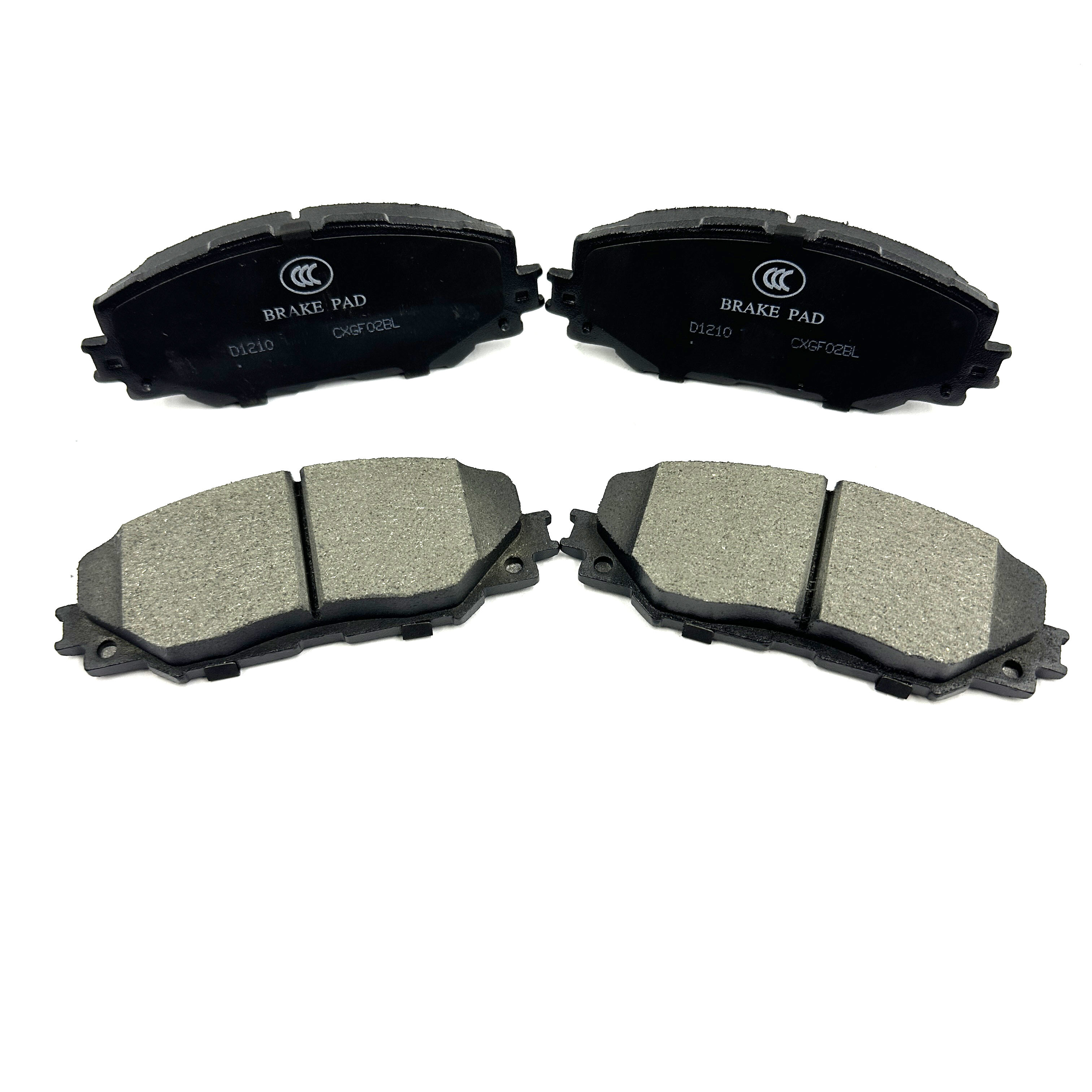Are Semi-Metallic Brake Pads the Best Option for High-Performance Vehicles?
High-performance vehicles—whether sports cars, muscle cars, or tuned sedans—demand brake pads that can keep up with their power. These cars accelerate faster, reach higher speeds, and often see aggressive driving (like track days or spirited highway runs), putting extra stress on brakes. Among the options, semi-metallic brake pads are a popular choice, but are they truly the best? Let’s break down their strengths, weaknesses, and how they stack up for high-performance needs, to help you decide if semi-metallic brake pads are right for your vehicle.
What Are Semi-Metallic Brake Pads?
Semi-metallic brake pads are made from a blend of materials: 30–60% metal (like steel, copper, iron, or brass) mixed with organic fibers (such as rubber, Kevlar, or glass) and a binding resin. This mix balances the heat resistance of metals with the flexibility of organic materials, creating a pad designed for durability and consistent performance under stress.
Unlike fully metallic pads (rare today, mostly for racing), semi-metallic brake pads are softer and more street-friendly. They’re also harder and more heat-resistant than organic pads (made mostly from rubber, cellulose, and resins) or ceramic pads (which use ceramic fibers and copper).
Why Semi-Metallic Brake Pads Work for High-Performance Vehicles
High-performance vehicles need brake pads that can handle three key challenges: extreme heat, frequent hard braking, and consistent stopping power. Semi-metallic brake pads excel in these areas:
1. Heat Resistance (No More Brake Fade)
When you hit the brakes hard—say, slowing from 120 mph to 40 mph on a track—brakes generate intense heat. If pads overheat, they lose friction (a problem called “brake fade”), making stopping distances longer and unpredictable.
Semi-metallic brake pads handle heat better than organic or ceramic pads. The metal content conducts heat away from the pad surface, preventing overheating. Even after repeated hard stops (like lap after lap on a track), they maintain their friction level, so your brakes feel reliable every time you press the pedal.
For example, a sports car with semi-metallic brake pads can complete 20+ track laps without noticeable fade, while organic pads might start fading after 5–8 laps.
2. Durability for Aggressive Driving
High-performance vehicles aren’t just fast—they’re often driven hard. Whether you’re accelerating quickly and braking sharply on back roads or pushing limits on a track, your brake pads take a beating.
Semi-metallic brake pads are tough. The metal fibers make them more resistant to wear from frequent hard braking. They last 20–50% longer than organic pads in high-performance use, reducing the need for frequent replacements. For someone who hits the track monthly, this means fewer trips to the shop and more time driving.
3. Strong, Consistent Stopping Power
In high-performance driving, split-seconds matter. Semi-metallic brake pads provide strong, predictable friction from the moment you press the pedal—even when cold. This “bite” is crucial for quick, confident stops, whether avoiding a hazard or setting a fast lap time.
Ceramic pads, while smooth, often need more heat to reach their optimal friction level. Organic pads, though soft, lack the raw stopping power needed for heavy, fast cars. Semi-metallic brake pads strike a balance: immediate response and strong stopping force, even in demanding situations.

When Semi-Metallic Brake Pads Might Not Be Ideal
While semi-metallic brake pads shine in high-performance scenarios, they have drawbacks that make them less perfect for every driver:
- Noise and Vibration: The metal content can make semi-metallic brake pads noisier than ceramic or organic pads. They may produce a high-pitched squeal, especially when cold, which some drivers find annoying.
- Hard on Rotors: The metal fibers are abrasive, so semi-metallic brake pads can wear down rotors faster than ceramic pads. This means you might need to replace rotors more often, adding to long-term costs.
- Stiff Feel: They often have a firmer pedal feel, which is great for precision driving but can feel harsh during daily commutes. For someone who uses their high-performance car mostly for errands, this stiffness might be uncomfortable.
How Semi-Metallic Brake Pads Compare to Other Types
To understand if semi-metallic brake pads are best, compare them to the two main alternatives:
- Ceramic Brake Pads: Made from ceramic fibers and copper. They’re quiet, produce less dust, and are gentler on rotors. But they handle heat less effectively than semi-metallic brake pads, making them better for daily driving than track use.
- Organic Brake Pads: Made from rubber, glass, and resins. They’re cheap, quiet, and soft on rotors but fade quickly under heat and wear out fast. Only good for low-performance, casual driving.
For high-performance vehicles used aggressively, semi-metallic brake pads outperform ceramic and organic pads in heat resistance, durability, and stopping power. For high-performance cars driven mostly on streets, ceramic pads might be a better balance of performance and comfort—but they can’t match semi-metallic for track use.
Who Should Choose Semi-Metallic Brake Pads?
Semi-metallic brake pads are the best option if:
- You use your high-performance vehicle for track days, autocross, or frequent spirited driving.
- You prioritize heat resistance and consistent braking over quietness or rotor longevity.
- You need strong, immediate stopping power in all conditions (cold or hot).
They’re less ideal if:
- You drive your high-performance car mostly for daily commutes or highway cruising.
- Noise and rotor wear are major concerns.
- You prefer a softer, smoother pedal feel.
FAQ
Do semi-metallic brake pads work well in wet conditions?
Yes. The metal content provides good friction even when wet, making semi-metallic brake pads reliable in rain or snow—better than organic pads, which can lose grip when wet.
How long do semi-metallic brake pads last on high-performance vehicles?
In aggressive use (track days, frequent hard braking), they last 15,000–30,000 miles. For mixed use (some spirited driving, some daily), 30,000–50,000 miles.
Are semi-metallic brake pads more expensive than ceramic ones?
No, they’re usually similar in price. Semi-metallic brake pads cost slightly more than organic pads but less than high-end ceramic ones designed for performance.
Can semi-metallic brake pads damage my high-performance car’s rotors?
They’re harder on rotors than ceramic pads, but high-performance rotors (often made of stronger materials like cast iron or carbon) are designed to handle this wear. Regular rotor checks and maintenance will prevent damage.
Do semi-metallic brake pads require a break-in period?
Yes. Like all brake pads, they need 200–300 miles of gentle braking to “bed in” (form a uniform layer of friction material on the rotor). This ensures optimal performance and prevents uneven wear.
Are semi-metallic brake pads legal for street use?
Yes. They meet all safety standards for street driving, making them suitable for both track and daily use.
Can I use semi-metallic brake pads on a high-performance SUV?
Absolutely. SUVs are heavier, so they generate more heat during braking. Semi-metallic brake pads’ heat resistance makes them a strong choice for high-performance SUVs (like the Porsche Cayenne or BMW X5 M).
Table of Contents
- Are Semi-Metallic Brake Pads the Best Option for High-Performance Vehicles?
- What Are Semi-Metallic Brake Pads?
- Why Semi-Metallic Brake Pads Work for High-Performance Vehicles
- When Semi-Metallic Brake Pads Might Not Be Ideal
- How Semi-Metallic Brake Pads Compare to Other Types
- Who Should Choose Semi-Metallic Brake Pads?
-
FAQ
- Do semi-metallic brake pads work well in wet conditions?
- How long do semi-metallic brake pads last on high-performance vehicles?
- Are semi-metallic brake pads more expensive than ceramic ones?
- Can semi-metallic brake pads damage my high-performance car’s rotors?
- Do semi-metallic brake pads require a break-in period?
- Are semi-metallic brake pads legal for street use?
- Can I use semi-metallic brake pads on a high-performance SUV?

